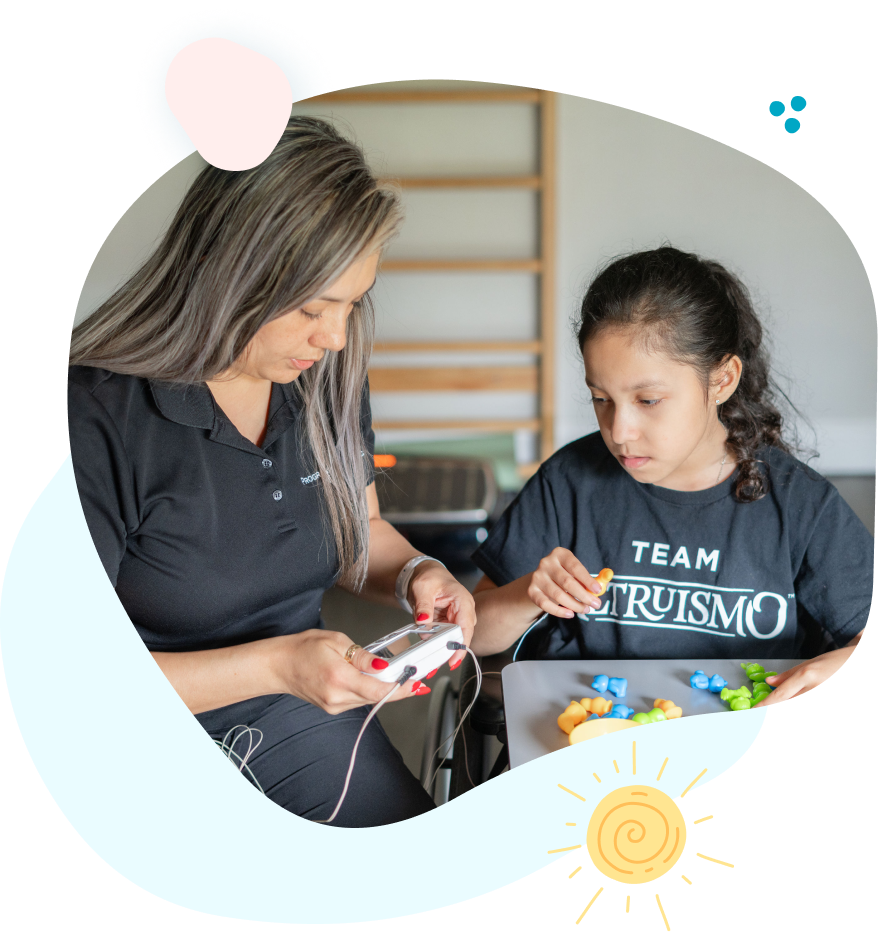Your Clinic
SET A LOCATION
Your Clinic
SET A LOCATION
Enhancing Muscle Function with Neuromuscular Electrical Stimulation (NMES) Therapy
Neuromuscular Electrical Stimulation (NMES) is a therapeutic modality increasingly used in pediatric rehabilitation to support recovery and improve functional abilities. This non-invasive treatment uses low level electrical impulses to stimulate nerves. Electricity is the ‘language of the nervous system’ – it is how the nervous system communicates with your body.
Electricity signals muscles to contract, as well as sends important sensory feedback to the spine and brain. When used correctly, NMES can help improve sensory awareness, motor control and postural alignment by targeting specific muscle groups to contract and develop a stronger connection between their nervous system and musculoskeletal structure.

Small electrodes are placed on the skin over the muscles or nerves being treated. A certified therapist then helps the child train their muscles with special exercises while the stimulation is being delivered. The personal response to stimulation is the most important indicator for treatment. NMES can be used while the child is resting but the most effective use of NMES is when it's used while trying to activate a muscle.
NMES strengthens atrophied muscles, supports neuromuscular re-education, and improves voluntary movement.
Electrical stimulation enhances sensory feedback, aiding children with sensory processing disorders.
NMES complements therapeutic exercises, improving range of motion, muscle endurance, and coordination.
Non-Invasive and Safe: NMES is tailored specifically to ensure effectiveness, comfort and safety with children of all ages.
Customized Protocols: Therapists individually program NMES using specific parameters such as intensity, frequency, duration, pulse width, and timing to address each child's age and unique needs.
Complementary Tool:
Combining NMES with other interventions like play-based therapy or guided exercises makes sessions engaging and effective. This holistic approach supports both motor and sensory development, promoting better rehabilitation results.
Children often tolerate serial bracing well and may develop:
NMES builds muscle strength and size in weakened muscles, especially after surgery or due to general weakness
NMES can modulate reflexes and help reduce spasticity (muscle stiffness) to help children gain range of motion, flexibility, sensory awareness and active movement control
In some cases, NMES can be used to alleviate pain associated with muscle spasms or contractures.
NMES may be used to directly activate spinal neurons promoting nerve connections in the spinal cord to assist with sensory, motor, and bowel and bladder function.
NMES can promote nerve regeneration and muscle activation for nerve injuries that may occur in children.
The NMES settings (intensity, pulse duration, electrode placement) need to be carefully tailored to each child's needs and specific condition
Proper training and expertise are required to safely and effectively administer NMES therapy
Neuromuscular Electrical Stimulation is an innovative therapy that empowers children to regain and enhance functional abilities. Pediatric physical and occupational therapists use NMES to activate motor and sensory pathways. As NMES communicates with a child’s nervous system, it helps make connections to build strength, sensory awareness and greater independence.
We empower children, families, and the community to learn, grow, and celebrate every child's unique abilities.
Quick Links
Clinic Locations
All Rights Reserved | Progressive Pediatric Therapy, Inc. | Privacy Policy | Terms of Service
Site by Spearlance